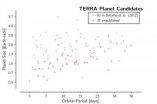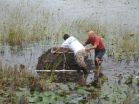(Press-News.org) A synthetic "poop" developed at the University of Guelph can cure nasty gastrointestinal infections caused by Clostridium difficile, a toxin-producing bacterium.
A study on the artificial stool was published today in the inaugural issue of Microbiome, a new peer-reviewed science journal.
The stool – a "super-probiotic" called RePOOPulate – was created by Guelph microbiologist Emma Allen-Vercoe to replace human fecal matter used in stool transplants, a known treatment for C. difficile.
She made the super-probiotic from purified intestinal bacterial cultures grown in "Robo-gut" equipment in a Guelph laboratory that mimics the environment of the large intestine.
Besides offering an effective therapy against the deadly superbug, the artificial poop is safer, more stable and adaptable, and less "icky" than treatments for C. difficile infection such as fecal bacteriotherapy, the study said.
"It's an exciting finding," said Allen-Vercoe, a professor in Guelph's Department of Molecular and Cellular Biology.
She worked on the project with lead researchers Dr. Elaine Petrof, an infectious disease specialist at Kingston General Hospital and a professor at Queen's University, and Gregory Gloor, a biochemistry professor at the University of Western Ontario. Guelph pathobiology professor Scott Weese and researcher Michelle Daigneault were also involved.
C. difficile can overpopulate the colon when antibiotics kill healthy gut bacteria. C. difficile infection causes many gastrointestinal problems, including severe diarrhea, and often leads to outbreaks in hospitals and long-term care facilities.
Few treatments exist for people with recurring C. difficile infections. Stool transplants are among the more effective therapies, but human fecal matter may contain unknown pathogens, Allen-Vercoe said. "That puts people at risk for future disease."
Stool transplants are also limited by lack of acceptance among patients and health-care facilities and lack of standardized treatment regimens.
Using synthetic poop for transplants eliminates the risk of transmitting an infectious disease through fecal bacteria because "the exact composition of the bacteria administered is known and can be controlled," Allen-Vercoe said.
The method may be modified to suit individual patient needs, is easily reproduced, and is more appealing to many patients and physicians, she said.
The researchers tested RePOOPulate on two patients with chronic C. difficile infections who had previously failed to respond to several rounds of antibiotics. After treatment with the synthetic poop, both were symptom-free within three days and tested negative for C. difficile six months later.
As well, later microbial profiles of both patients showed that some features of the synthetic stool stabilized in their colons. "In other words, the introduced microbes were able to persist," Allen-Vercoe said. "This is important because most commercially available probiotics only colonize transiently."
Allen-Vercoe hopes doctors will one day use the RePOOPulate concept to treat other GI conditions, such as inflammatory bowel disease, obesity and even autism by replacing abnormal gut microbial ecosystems.
INFORMATION: END
An analysis of the first three years of data from NASA's Kepler mission, which already has discovered thousands of potential exoplanets, contains good news for those searching for habitable worlds outside our solar system.
It shows that 17 percent of all sun-like stars have planets one to two times the diameter of Earth orbiting close to their host stars, according to a team of astronomers from the University of California, Berkeley, and the University of Hawaii at Manoa.
This estimate includes only planets that circle their stars within a distance of about one-quarter ...
COLUMBIA, Mo. -- The hand-held scanners, or tricorders, of the Star Trek movies and television series are one step closer to reality now that a University of Missouri engineering team has invented a compact source of X-rays and other forms of radiation. The radiation source, which is the size of a stick of gum, could be used to create inexpensive and portable X-ray scanners for use by doctors, as well as to fight terrorism and aid exploration on this planet and others.
"Currently, X-ray machines are huge and require tremendous amounts of electricity," said Scott Kovaleski, ...
(Santa Barbara, Calif.) –– For decades, consensus among psychologists has held that a group of five personality traits –– or slight variations of these five –– are a universal feature of human psychology. However, a study by anthropologists at UC Santa Barbara raises doubt about the veracity of that five-factor model (FFM) of personality structure as it relates to indigenous populations. Their findings appear in the current issue of the American Psychological Association's Journal of Personality and Social Psychology.
Studying the Tsimane, an isolated indigenous group ...
Cambridge, Mass. - January 8, 2013 - At a time when communication networks are scrambling for ways to transmit more data over limited bandwidth, a type of twisted light wave is gaining new attention. Called an optical vortex or vortex beam, this complex beam resembles a corkscrew, with waves that rotate as they travel.
Now, applied physicists at the Harvard School of Engineering and Applied Sciences (SEAS) have created a new device that enables a conventional optical detector (which would normally only measure the light's intensity) to pick up on that rotation.
The ...
Testing medicines to prevent lung cancer requires treating many thousands of high-risk individuals and then waiting 5, 10 or 15 years to discover which of them develop cancer and which, if any, experience survival benefit from the treatment. A University of Colorado Cancer Center study recently published in the journal Cancer Prevention Research proposes a possible waypoint on the way to benefit, which if validated, could dramatically reduce the number of patients needed and time required to test drugs for lung cancer prevention.
"Chemoprevention is an important approach ...
ROSEMONT, Ill.—Female athletes are three times more likely to suffer from anterior cruciate ligament (ACL) ruptures, one of the most common knee injuries, compared to male athletes. The ACL is one of the four main ligaments within the knee that connect the femur (upper leg bone) to the tibia (lower leg bone). Recent research highlights the unique anatomical differences in the female knee that may contribute to higher injury rates, and should be taken into consideration during reconstructive surgery and sports training, according to a review article in the January 2013 issue ...
LA JOLLA, CA – January 8, 2013 - Chemists at The Scripps Research Institute (TSRI) have found an easier way to perform one of the most fundamental tasks in molecular biology. Their new method allows scientists to add a marker to certain cells, so that these cells may be easily located and/or selected out from a larger cell population.
The technique, which is described in a recent issue of the chemistry journal Angewandte Chemie International Edition, makes use of the tight binding of two proteins that are cheaply obtainable but are not found in human or other mammalian ...
Foreign invaders such as pythons and lionfish are not the only threats to Florida's natural habitat. The native Carolina Willow is also starting to strangle portions of the St. Johns River.
Biologists at the University of Central Florida recently completed a study that shows this slender tree once used by Native Americans for medicinal purposes, may be thriving because of water-management projects initiated in the 1950s. Canals were built to control runoff and provide water for agriculture. The unintended consequence -- stable water levels -- allowed Carolina Willow ...
New York children participating in a federal nutrition program had healthier eating behaviors and lower rates of obesity two years after improvements to the program were undertaken, according to a study published online today in Obesity, the official journal of the Obesity Society.
In 2009 all 50 states rolled out sweeping changes to the menu of foods available through the Special Supplemental Nutrition Program for Women, Infants, and Children, or WIC, which reaches nearly half of all infants born in the United States. New York was the first state in the nation to roll ...
A new American Chemical Society (ACS) video provides a behind-the-scenes-look at the DayGlo Color Corp. factory, producer of the fluorescent paints that light up traffic cones, black light posters, hula-hoops and other products. The video, the latest episode of the award-winning Bytesize Science series from the world's largest scientific society, is at www.BytesizeScience.com.
Inside DayGlo opens with a brief history of the company, which has been designated as an ACS National Historic Chemical Landmark, and continues with an in-depth look inside its main production ...



